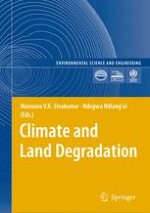2007 | OriginalPaper | Buchkapitel
Climate and Land Degradation — an Overview
verfasst von : Mannava V. K. Sivakumar, Robert Stefanski
Erschienen in: Climate and Land Degradation
Verlag: Springer Berlin Heidelberg
Aktivieren Sie unsere intelligente Suche, um passende Fachinhalte oder Patente zu finden.
Wählen Sie Textabschnitte aus um mit Künstlicher Intelligenz passenden Patente zu finden. powered by
Markieren Sie Textabschnitte, um KI-gestützt weitere passende Inhalte zu finden. powered by
The definition of land degradation in the United Nations Convention to Combat Desertification (UNCCD) gives explicit recognition to climatic variations as one of the major factors contributing to land degradation. In order to accurately assess sustainable land management practices, the climate resources and the risk of climate-related or induced natural disasters in a region must be known. Land surface is an important part of the climate system and changes of vegetation type can modify the characteristics of the regional atmospheric circulation and the large-scale external moisture fluxes. Following deforestation, surface evapotranspiration and sensible heat flux are related to the dynamic structure of the low-level atmosphere and these changes could influence the regional, and potentially, global-scale atmospheric circulation. Surface parameters such as soil moisture, forest coverage, transpiration and surface roughness may affect the formation of convective clouds and rainfall through their effect on boundary-layer growth. Land use and land cover changes influence carbon fluxes and GHG emissions which directly alter atmospheric composition and radiative forcing properties. Land degradation aggravates CO
2
-induced climate change through the release of CO
2
from cleared and dead vegetation and through the reduction of the carbon sequestration potential of degraded land.
Climate exerts a strong influence over dry land vegetation type, biomass and diversity. Precipitation and temperature determine the potential distribution of terrestrial vegetation and constitute principal factors in the genesis and evolution of soil. Precipitation also influences vegetation production, which in turn controls the spatial and temporal occurrence of grazing and favours nomadic lifestyle. The generally high temperatures and low precipitation in the dry lands lead to poor organic matter production and rapid oxidation. Low organic matter leads to poor aggregation and low aggregate stability leading to a high potential for wind and water erosion. The severity, frequency, and extent of erosion are likely to be altered by changes in rainfall amount and intensity and changes in wind. Impacts of extreme events such as droughts, sand and dust storms, floods, heat waves, wild fires etc., on land degradation are explained with suitable examples. Current advances in weather and climate science to deal more effectively with the impacts of different climatic parameters on land degradation are explained with suitable examples. Several activities promoted by WMO’s programmes around the world help promote a better understanding of the interactions between climate and land degradation through dedicated observations of the climate system; improvements in the application of agrometeorological methods and the proper assessment and management of water resources; advances in climate science and prediction; and promotion of capacity building in the application of meteorological and hydrological data and information in drought preparedness and management. The definition of land degradation adopted by UNCCD assigns a major importance to climatic factors contributing to land degradation, but there is no concerted effort at the global level to systematically monitor the impacts of different climatic factors on land degradation in different regions and for different classes of land degradation. Hence there is an urgent need to monitor the interactions between climate and land degradation. To better understand these interactions, it is also important to identify the sources and sinks of dryland carbon, aerosols and trace gases in drylands. This can be effectively done through regional climate monitoring networks. Such networks could also help enhance the application of seasonal climate forecasting for more effective dryland management.
